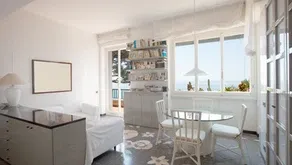ADU Changes in California
The housing demand in recent years has driven home prices so high that the lack of affordable housing has finally prompted a change in legislation to alleviate the scarcity in living spaces, and part of the solution are three letters that have been popping up all over the real estate space - “ADU”, or Accessory Dwelling Units.
Accessory Dwelling Units (ADUs) – may also be called various names e.g. in-laws, secondary units, Junior Accessory Dwelling Unit (JADU), etc., and we can get into the details of the qualifications, but these are essentially a fully functioning living space that are either attached, detached, a garage conversion, a storage area conversion, or even an interior conversion such as an in-law, and I in my opinion, the term that best captures this type of living area is “accessory structure”.
Benefits of an ADU:
Simply put, they:
- Provides additional living spaces on existing property.
- Provides a level of autonomy to the people living in the property while also potentially providing a source of income to the property owner.
- Maximizes the land already owned.
Process & Qualification Changes:
- ADU applications must be decisioned within 60 days of submission of the application as opposed to 120 days (application must adhere to the CEQA*) – This speeds up time frames, especially if costs are involved.
- Additional color here, application approval processes were layered with personal judgement by multiple public officials with multiple governmental decisions, but now the approval process is done ministerially, meaning an approval is based on fixed standards as opposed to discretion.
- Properties no longer need to be owner-occupied to build an ADU on the lot. Allows more freedoms as well as the ability to maximize any rental properties you own. (This exemption is valid thru to January 1, 2025)
- If an existing garage is converted to an ADU then there are no setback requirements.
- If a garage is converted into an ADU, local ordinances cannot require you to replace the parking space.
- Owners of existing unpermitted “ADUs” now have the option to legalize their units via having building inspectors apply building standards that were applicable at the time the unit was built and the inspectors can also approve materials, appliances, installations etc. at their discretion if they find that the unit is satisfactory.
- The following construction limitations no longer apply when building an ADU:
- The minimum setback was lowered to 4 ft. of space from the side and rear lot line – this helps alleviate lot space restrictions.
- You are now allowed an ADU up to 1,200 Sq. Ft. as well as a JADU up to 500 Sq. Ft. so long as they are contained within the existing family structure.
- *Notable Caveat: A Maximum Sq. Ft. requirement may be imposed if an ADU is < 850 Sq. Ft. and/or <1000 Sq. Ft. and provides more than 1 bedroom.
Cost Impacts:
- Fees & costs associated with building an ADU have been reduced.
- Impact Fees specifically have been greatly decreased and/or diminished altogether, and in some cases even waived if the ADU is <750 Sq. Ft. or the fee is proportionately assessed in relation to the Sq. Ft. of the primary dwelling.
- A local agency, special district, or water corporation shall not impose any impact fees upon the development of an ADU <750 Sq. Ft.
What are Impact Fees?:
- Impact fees can cost more than 10% of your total budget.
- They are assessed for new contractions and said to pay for various local services in the area; however, these impact fees also impede development because they disincentive developers since they can cut too deep into their profits.
- “Impact” fees vary from locale to locale, but a common example list of fees concerning the development of a new ADU would include the following: (any fees that Impact the surrounding area are designated as Impact fees. The items in bold would be impact fees, and they may not always be specified as such.)
- Building Permits
- Building Plans
- Plan Checks
- Engineering Checks
- Electrical and Plumbing Checks
- Mechanical Checks
- Materials
- Debris
- Park Impact Fees
- Housing Impact Fees
- Traffic Impact Fees
- School Impact Fees
Notable Restrictions & Mentions (others may apply):
- The total floor area for an attached ADU cannot exceed 50% of the existing primary home.
- Multifamily homes are also required to be approved to house multiple ADUs
- A prohibition on the sale of the JADU separate from the sale of the single-family residence (enforced against future purchasers as well)
- A restriction on the size and attributes of the JADU to conform to Section 65852.22 ( here )
- Permitted JADU must be constructed within the walls of the proposed or existing single-family residence.
- A permitted JADU must include a separate entrance.
- A JADU must include an efficiency kitchen: cooking facility with appliances, food preparation counter and storage cabinets of reasonable size in relation to the size of the JADU.
Other Notable Caveats to Keep in Mind (others may apply):
- The application time may be longer if you are submitting a permit application to build a primary unit & and an ADU at the same time.
- A local agency cannot issue a Cert. of Occupancy (CoO) for an ADU prior to the CoO for the primary residence first being issued.
- A local agency may impose more limitations if the real property is listed in California’s Register of Historic Places.
- If a JADU is built with an ADU, the local agency may impose a total floor area limitation of no more than 800 Sq. Ft. and a height limitation of 16 Ft.
- Fire sprinklers are not required in an ADU if they are not required in the primary residence.
- A local agency may impose that any ADU used as a rental be for a term longer than 30 days.
- A local agency may require that a percolation test be completed within the last 5 years or recertified in the last 10 as part of the application to create an ADU.
- An ADU shall not be considered to be a “new residential” use for purposes of recalculating connection fees or capacity charges for utilities unless the ADU was constructed with a new single-family residence.
* CEQA – These guidelines determine whether an activity is subject to environmental review, and what additional steps are required or not required - https://www.opr.ca.gov/ceqa/
*The information provided on this website does not, and is not intended to, constitute legal, tax, or construction advice; instead, all information, content, and materials available on this site are for general informational purposes only. Information on this website may not constitute the most up-to-date legal or other information. This website may contain links to other third-party websites. Such links are only for the convenience of the reader, user, or browser.
Readers of this website should contact their attorney, tax accountant, or contractor to obtain advice with respect to any particular legal, tax, or construction matter. Only your individual attorney, tax, or construction advisor can provide assurances that the information contained herein – and your interpretation of it – is applicable or appropriate to your particular situation.
The views expressed at, or through, this site are those of the individual author's writing in their individual capacity only. All liability with respect to actions taken or not taken based on the contents of this site are hereby expressly disclaimed. The content on this posting is provided "as is;" no representations are made that the content is error-free.














